You are using an out of date browser. It may not display this or other websites correctly.
You should upgrade or use an alternative browser.
You should upgrade or use an alternative browser.
Soviet Fantastic Painting
- Thread starter WotanArgead
- Start date
Gennady Grigorievich Golobokov
In 1973, at the International Exhibition of Sci-Fi Art "The Cosmos of Tomorrow", the jury, chaired by cosmonaut-artist A. Leonov, awarded the young artist Gennady Golobkov with the first-degree diploma. One by one he receives first prizes in competitions: "The World of Tomorrow", "The World 2000", "Siberia tomorrow", "Time - Space - Man". The stream is admired by visitors, astronauts, scientists, artists, thousands of ordinary people. Write admired articles of the newspaper and magazines.
About Golobkov speak as the pioneer of the direction of "psychological fiction" in painting, the main theme of whose work is the psychology of the people of the future.
Golobkov's paintings are not at all ideal, but they have an amazing life force and moral integrity. The heroes of the paintings were what the Soviet people wanted to see in their descendants, the next step in the development of people of the near future - spirituality, will, responsibility, moral purity, a discreet but unbending sense of duty, contempt for death. People seemed to see in them the heroes of the books of Efremov, Bogdanov, Strugatsky ...
None of the jury knew about the fact that Gennady Golobkov almost completely paralyzed invalid of the 1st group: the artist insisted on this, he did not want any discounts to himself, no pity. He defeated everyone in fair competition who had everything right with his hands, who could sit down without someone else's help, for whom it was not a problem to move the canvas and go to another city for an exhibition.
Golobokov's paintings are exhibited in Moscow, Kiev, Gorky, Prague, Budapest, Warsaw, Bratislava, Lisbon, Ulan Bator, even in Madagascar and in Laos ... Two pictures are bought by the American space center in Houston.
Friends of the artist were many Soviet cosmonauts, scientists, artists, writers, journalists. He received thousands of letters from unknowns.
This artist I love most - therefore, there will be more pictures than I usually show.

Dance with ball lightning

The Paradox of Time (Earth and Space)

Expectation

Sower

Continental shelf
About Golobkov speak as the pioneer of the direction of "psychological fiction" in painting, the main theme of whose work is the psychology of the people of the future.
Golobkov's paintings are not at all ideal, but they have an amazing life force and moral integrity. The heroes of the paintings were what the Soviet people wanted to see in their descendants, the next step in the development of people of the near future - spirituality, will, responsibility, moral purity, a discreet but unbending sense of duty, contempt for death. People seemed to see in them the heroes of the books of Efremov, Bogdanov, Strugatsky ...
None of the jury knew about the fact that Gennady Golobkov almost completely paralyzed invalid of the 1st group: the artist insisted on this, he did not want any discounts to himself, no pity. He defeated everyone in fair competition who had everything right with his hands, who could sit down without someone else's help, for whom it was not a problem to move the canvas and go to another city for an exhibition.
Golobokov's paintings are exhibited in Moscow, Kiev, Gorky, Prague, Budapest, Warsaw, Bratislava, Lisbon, Ulan Bator, even in Madagascar and in Laos ... Two pictures are bought by the American space center in Houston.
Friends of the artist were many Soviet cosmonauts, scientists, artists, writers, journalists. He received thousands of letters from unknowns.
This artist I love most - therefore, there will be more pictures than I usually show.

Dance with ball lightning

The Paradox of Time (Earth and Space)

Expectation

Sower

Continental shelf

In the park for 75 parallel

memorial (Monument)

One minute before landing
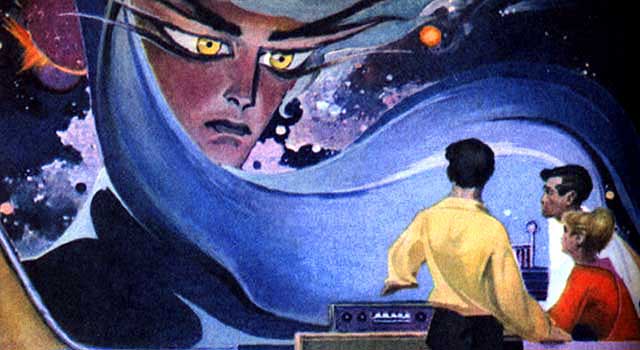
Great ring of the universe. Contact

Parting
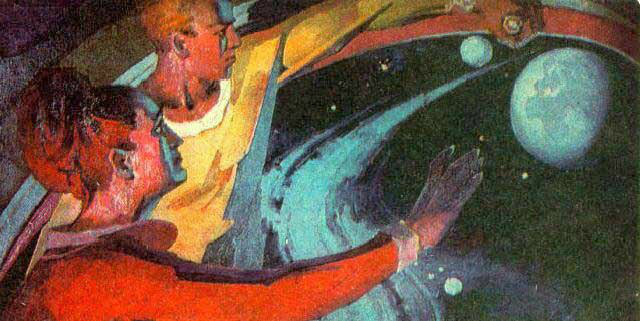
Farewell to the Earth
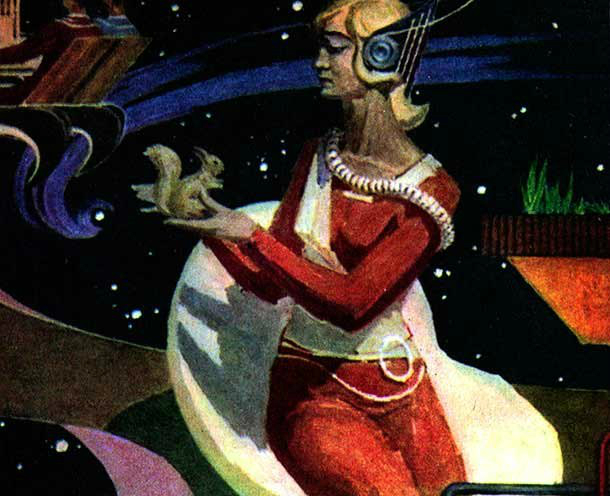
Earthly Squirrel
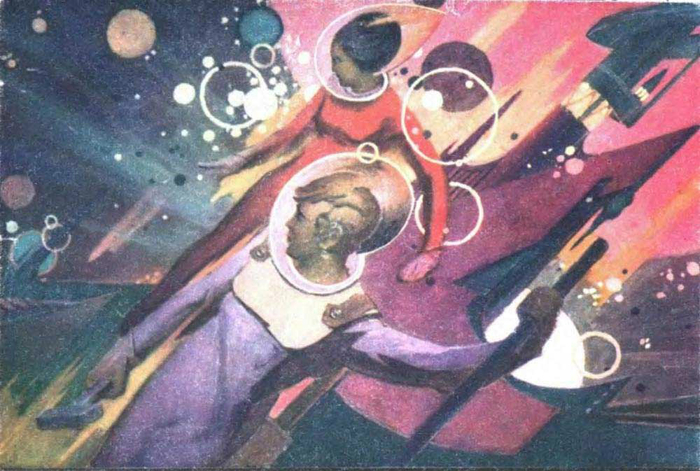
Space laborers
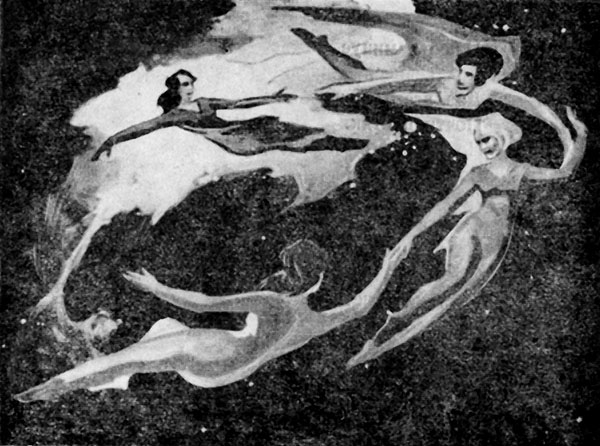
Space Mazurka
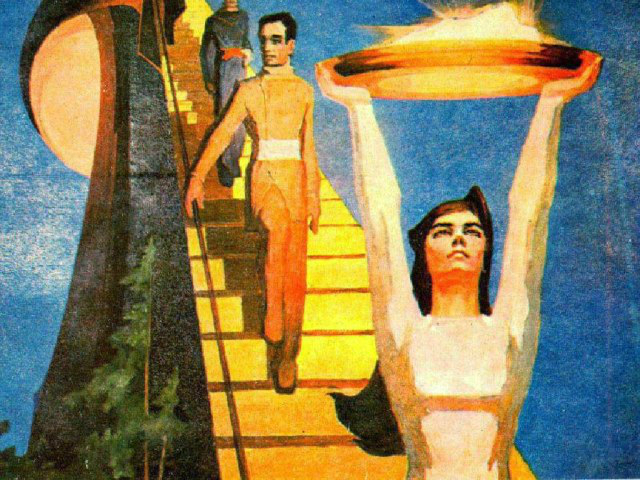
Bowl with the Sun (Bowl of Fire).
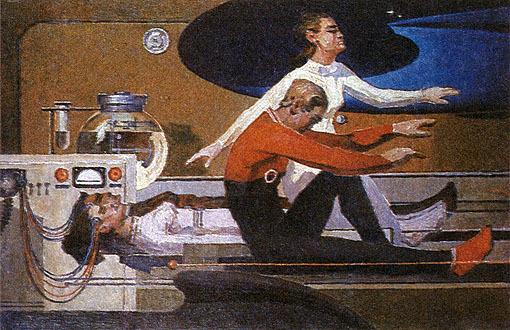
Exit from suspended animation
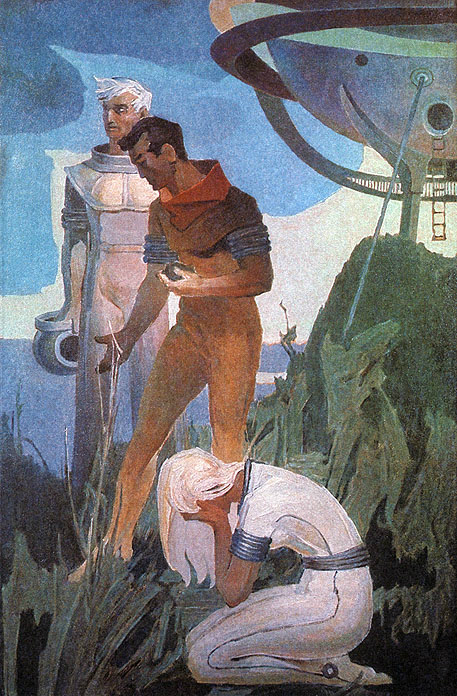
Return
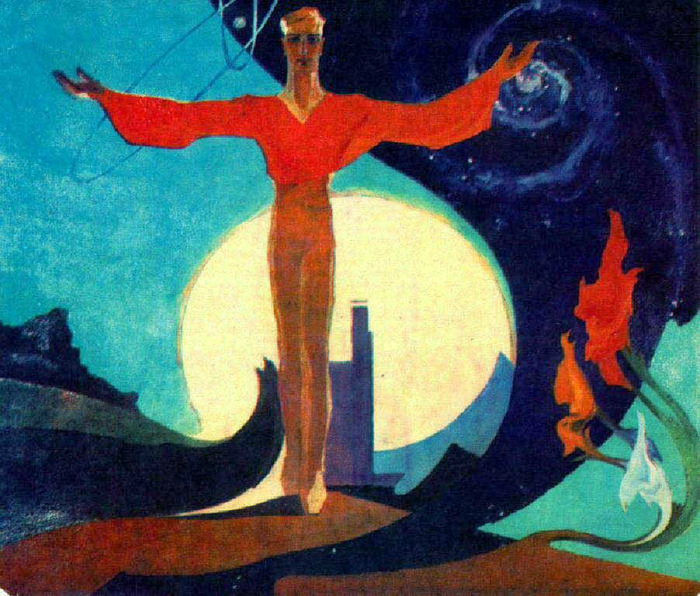
Worid of Human
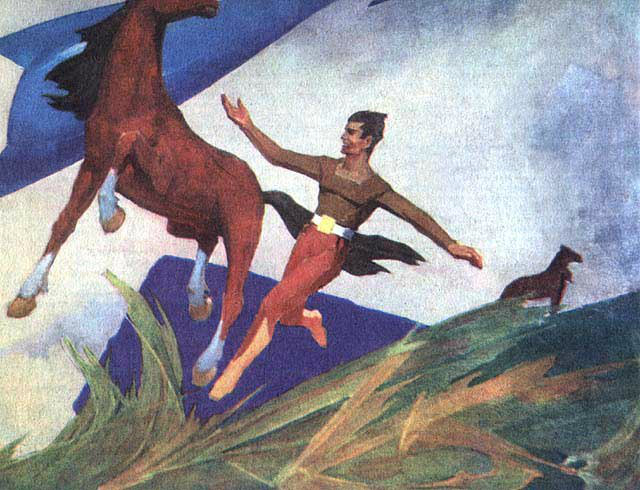
Friends
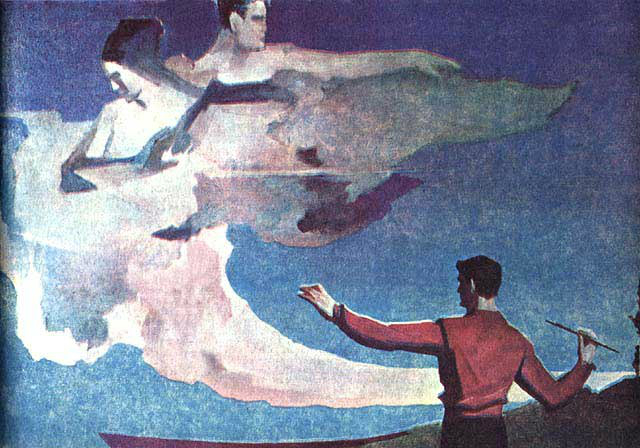
Aerie Sculptor
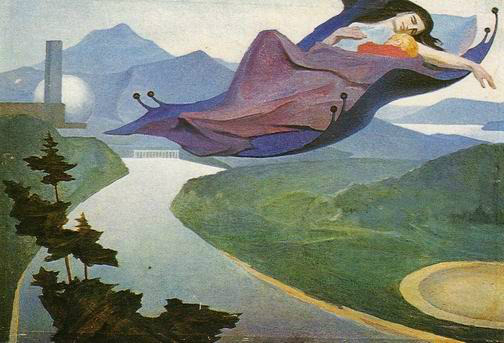
Carpet plane. Morning of Siberia - Tomorrow.
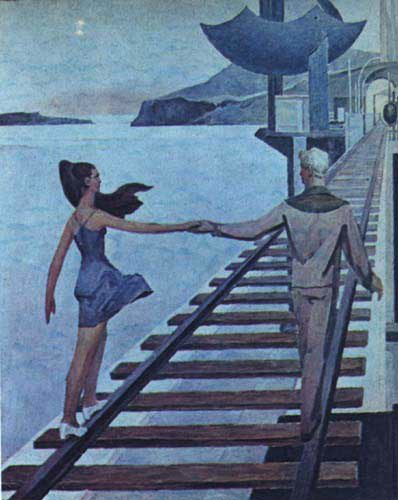
Siberia, tomorrow, the BAM.
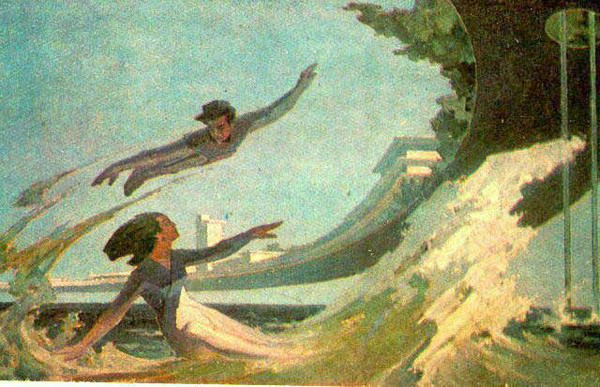
Flight
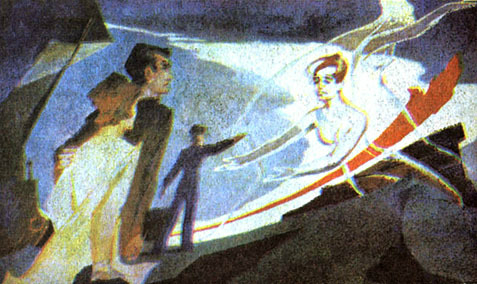
Running track of conjugate
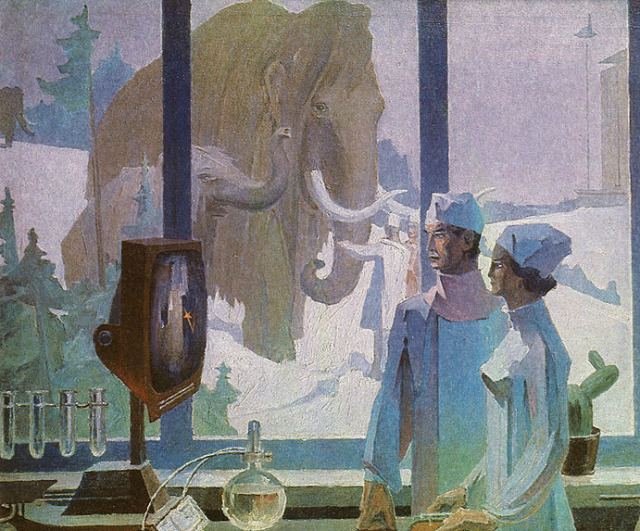
Research Institute of Genetics
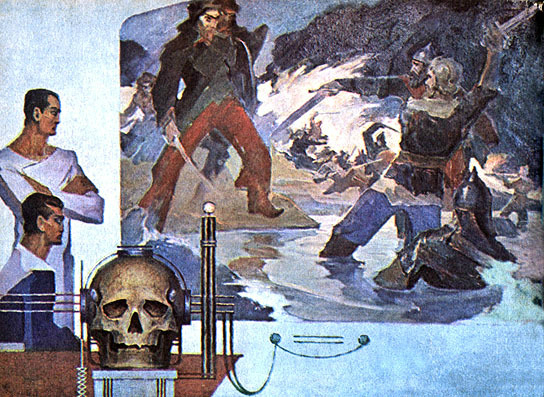
Skull of Kuchum (Note - the last khan of Siberia, whose possessions were occupied by Yermak)
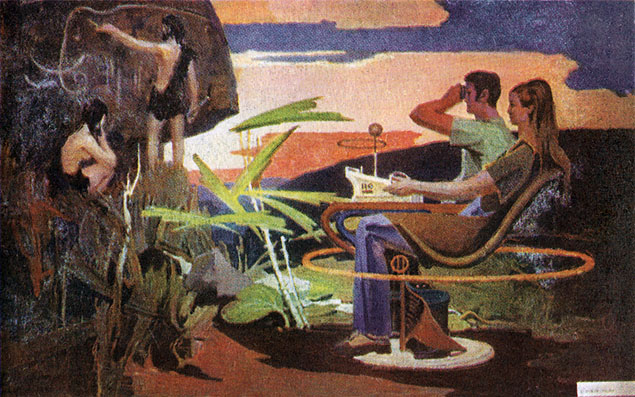
An excursion into the past

Flowers of the Descendants
Robert Avotin
Robert Avotin is a famous illustrator of the journal "Техника-Молодёжи". He graduated from the Moscow Art and Industrial School. M.I. Kalinin, worked in the industrial artel Khokhloma painting. He graduated from the Moscow Institute of Applied and Decorative Arts, the faculty of monumental painting of the Leningrad Art and Industrial School. IN AND. Fly. Thesis work - a colorful panel "Carpet weaving" - was demonstrated at the Moscow Festival of Youth and Students (1957) and at the All-Union Art Exhibition (1958).
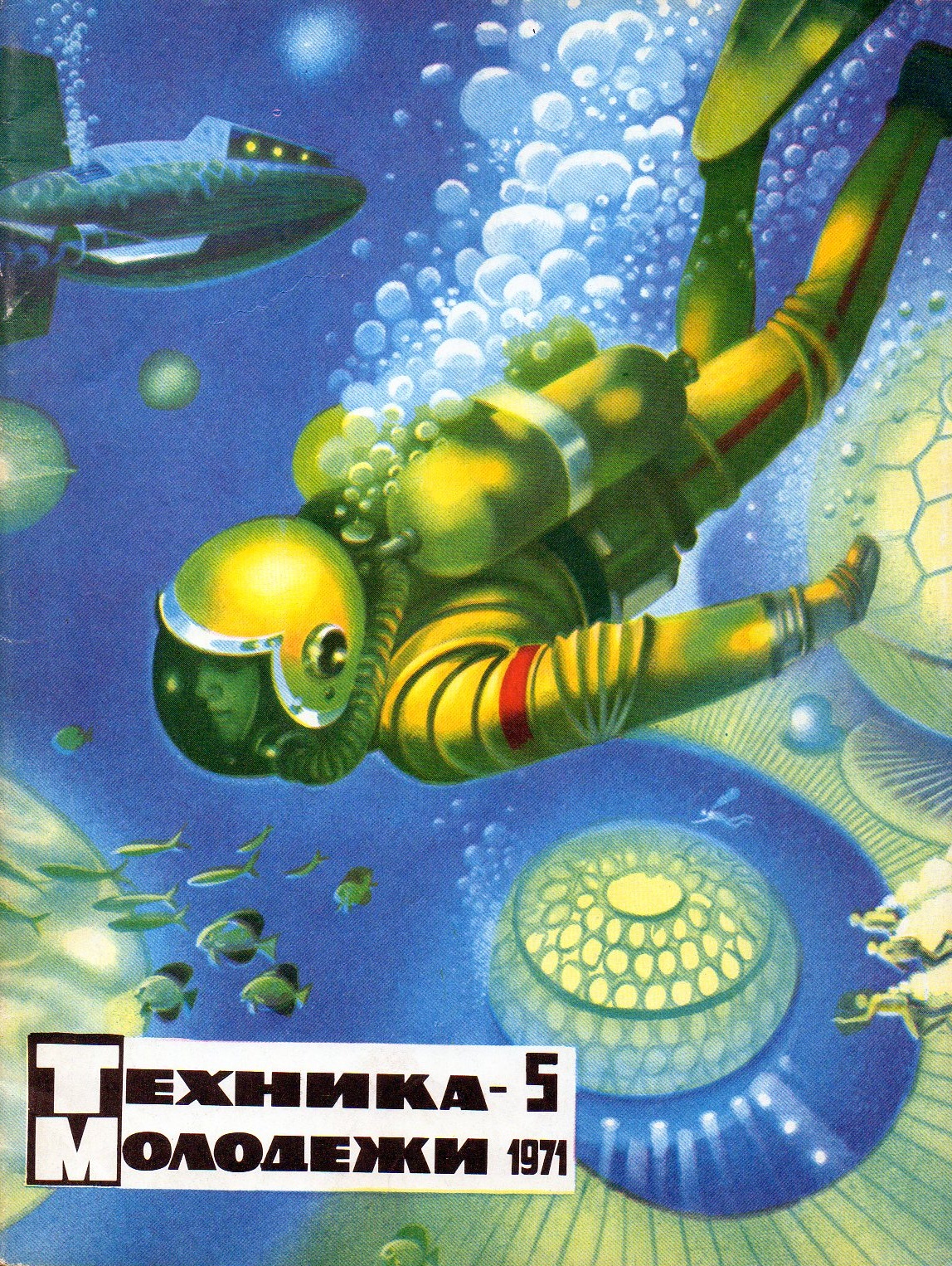
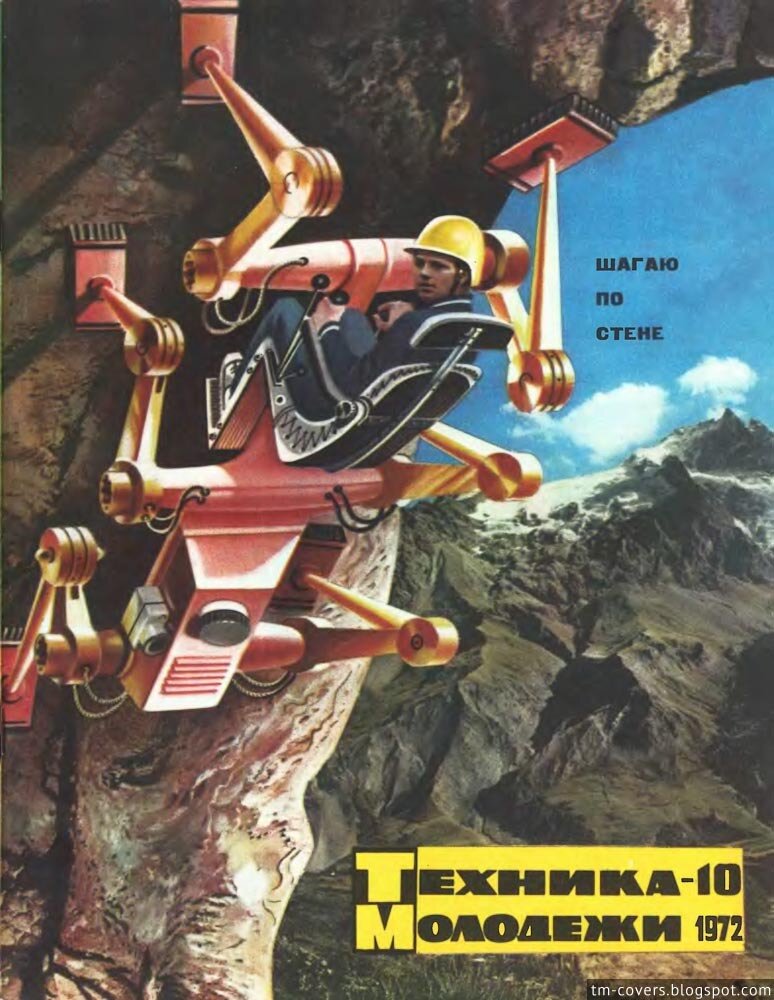

The last one is an illustration of Arthur Clark (The City and the Stars).


The last one is an illustration of Arthur Clark (The City and the Stars).
And what about Golobkov?Nice designs and artwork by Robert Avotin.
And what about Golobkov?
I found his style a little off for my tastes. He is good I admit, just not what I favor.
Alexander Belyy
Alexander Belyy - unfortunately I did not find any intelligible information about him, but his pictures are very interesting.

Cosmodrome

Meeting of two civilizations
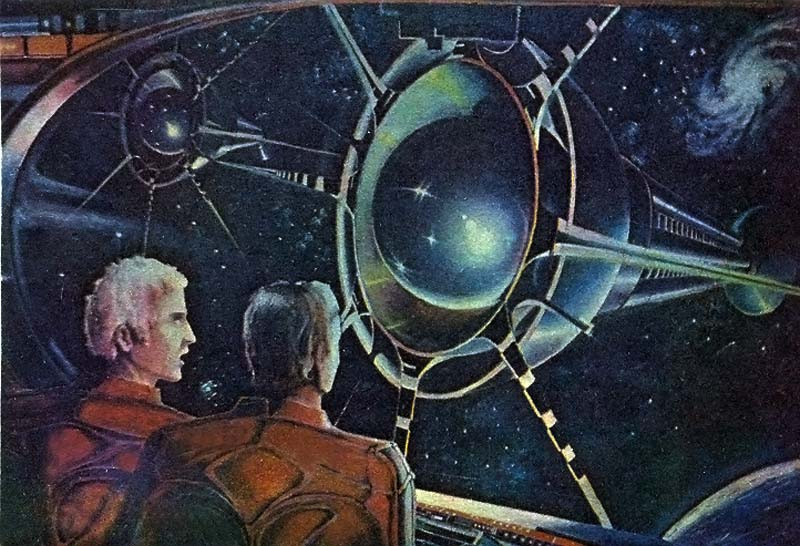
Before descending to the planet

Cosmodrome

Meeting of two civilizations

Before descending to the planet
Thande
Donor
Unlike the others, that one depicts a real event which Leonov participated in - at the end of the Apollo-Soyuz Test Project, the Apollo spacecraft undocked from the Soyuz and used its round hull to create an artificial solar eclipse which the Soyuz cosmonauts could observe. A simulation of it can be seen in this publicity film (made before the mission) around 8:30.Last week, Russia celebrated Cosmonautics Day. Also recently a relatively good Russian film "The Time of the First" came out on the screens, about the first human entry into space.
As some probably know in the 60s, in the USSR there was a boom of fancy fantasy, and a space theme in principle. Of course, this was reflected in the painting.
I would like to start with the artist cosmonaut - Alexei Arkhipovich Leonov.

Artificial solar eclipse
Cool - actually, Leonove is considered one of the founders of "cosmic realism" (together with Sokolov)Unlike the others, that one depicts a real event which Leonov participated in - at the end of the Apollo-Soyuz Test Project, the Apollo spacecraft undocked from the Soyuz and used its round hull to create an artificial solar eclipse which the Soyuz cosmonauts could observe. A simulation of it can be seen in this publicity film (made before the mission) around 8:30.
Last edited:
Nina Yakimovna
Our next guest is Nina Yakimovna. This woman is interesting because she is an astronomer.
Nina graduated from the Astronomical Department of the Physics Department of Moscow State University. In 1972 she defended her thesis on "Structure of the instability band of classical cepheids of the Galaxy and Magellanic clouds". A year later, I first tried drawing with water colors on wood. It is not surprising therefore that in her article "The Life-Giving Hands of the Earth" the scientist's logic and the artist's temperament are bizarrely connected.
And this union of two principles is one of the foundations of the identity of Nina Yakimova's creative manner.

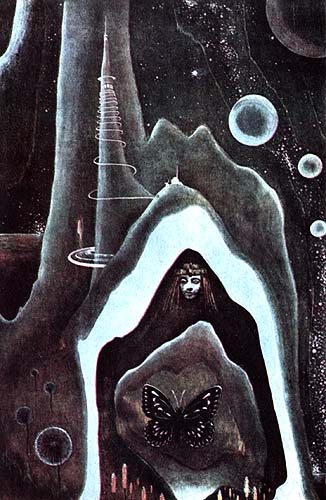
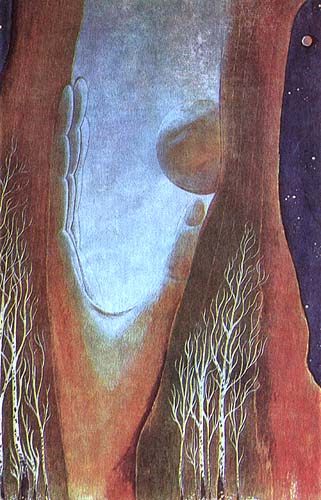
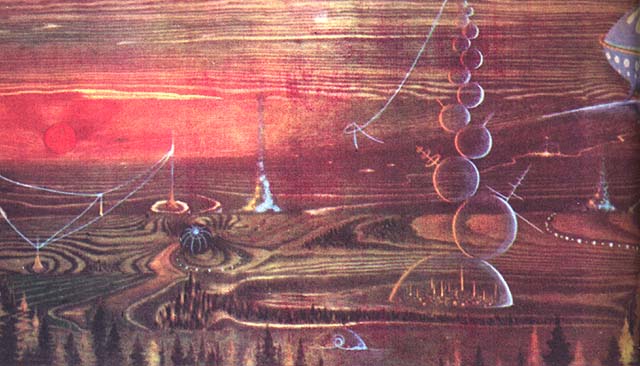
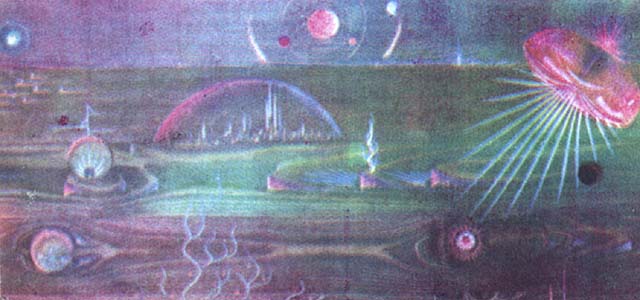
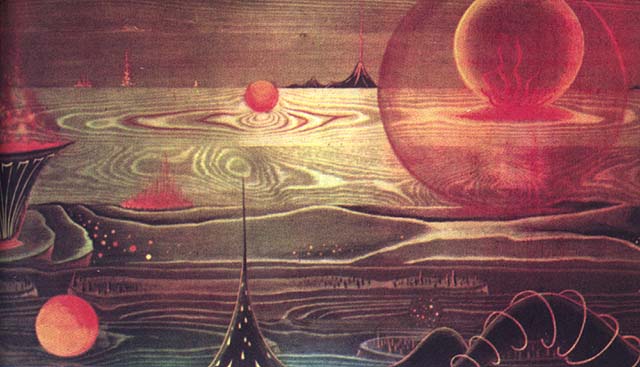
Nina graduated from the Astronomical Department of the Physics Department of Moscow State University. In 1972 she defended her thesis on "Structure of the instability band of classical cepheids of the Galaxy and Magellanic clouds". A year later, I first tried drawing with water colors on wood. It is not surprising therefore that in her article "The Life-Giving Hands of the Earth" the scientist's logic and the artist's temperament are bizarrely connected.
And this union of two principles is one of the foundations of the identity of Nina Yakimova's creative manner.

George Ivanovich Kurnin
George Ivanovich Kurnin (1915 Tashkent - April 14, 1988 Sochi) - a science fiction artist, art critic. The author of more than 30 monumental paintings with landscapes of other planets.
He was born in 1915 in Tashkent. He graduated from the Tashkent Art College, the Faculty of Art Studies of the Central Asian State University. Author of a number of landscapes dedicated to Central Asia. He had a unique visual memory, and therefore never wrote from nature. In 1949 he moved to Sochi, where he lived until the end of his days. I lectured on art history topics for Sochi artists. In the 70's with the creativity of Kurnina met cosmonaut Vitaly Ivanovich Sevastyanov, who later exerted a lot of effort to popularize the creative work of an extraordinary artist.
Reproductions of Kurnin's paintings were published in magazines and almanacs: "Technique - Youth", "Smena", "Ogonek", "The Soviet Union", "Ural Pathfinder", "Fantastic" - 1973-1976.
Kurnin's paintings were exhibited: at the International Congress of Astronauts in Baku, at the Moscow House of Scientists, at VDNKh. In Hungary, Czechoslovakia, Poland. (1973-1974)
He died on April 14, 1988 in Sochi. He was buried in the Old part of the Central Uspensky cemetery in Sochi.
About Kurnin three days before his death was filmed a television film, shown posthumously on Moscow television.
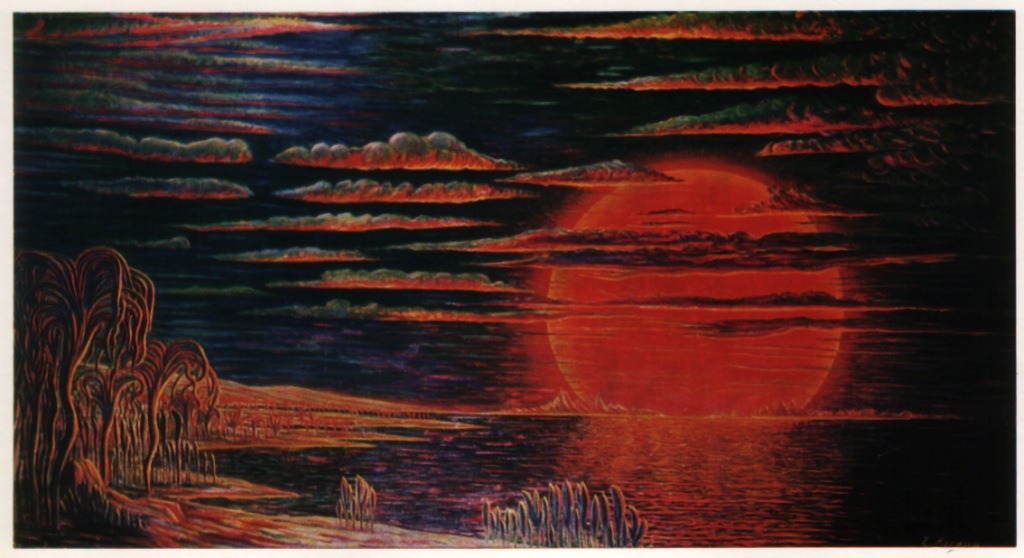
Planet of the Great Red Sun
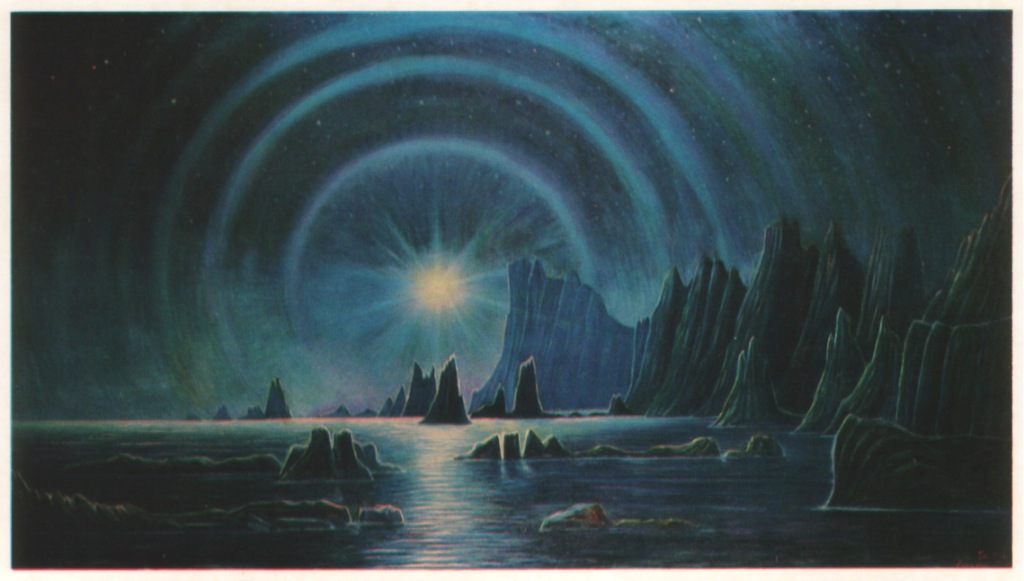
Supernova explosion
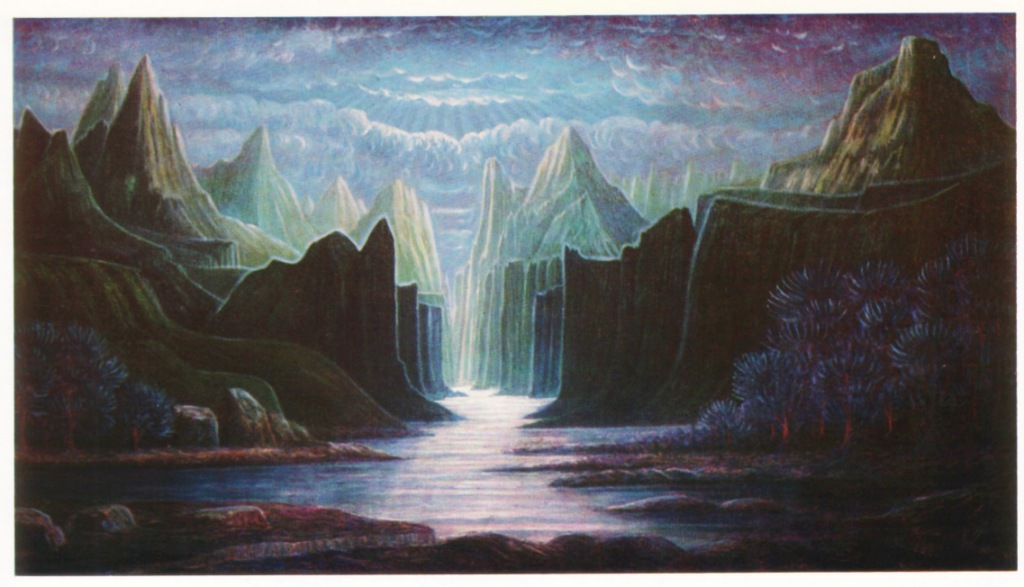
Landscape of Mars in the polar cap region
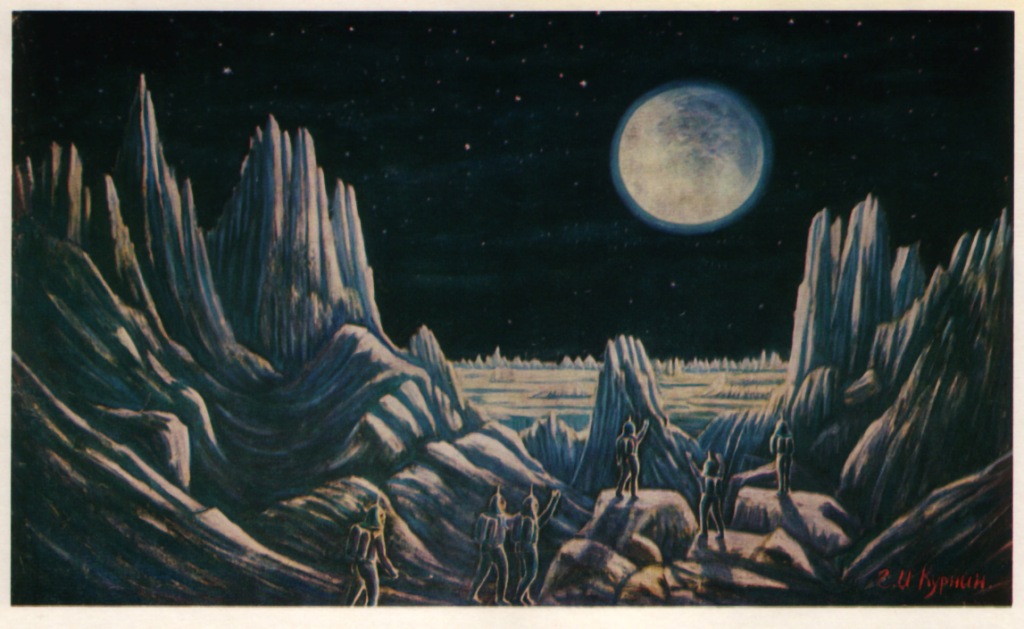
Landscape of the Moon, illuminated by the Earth
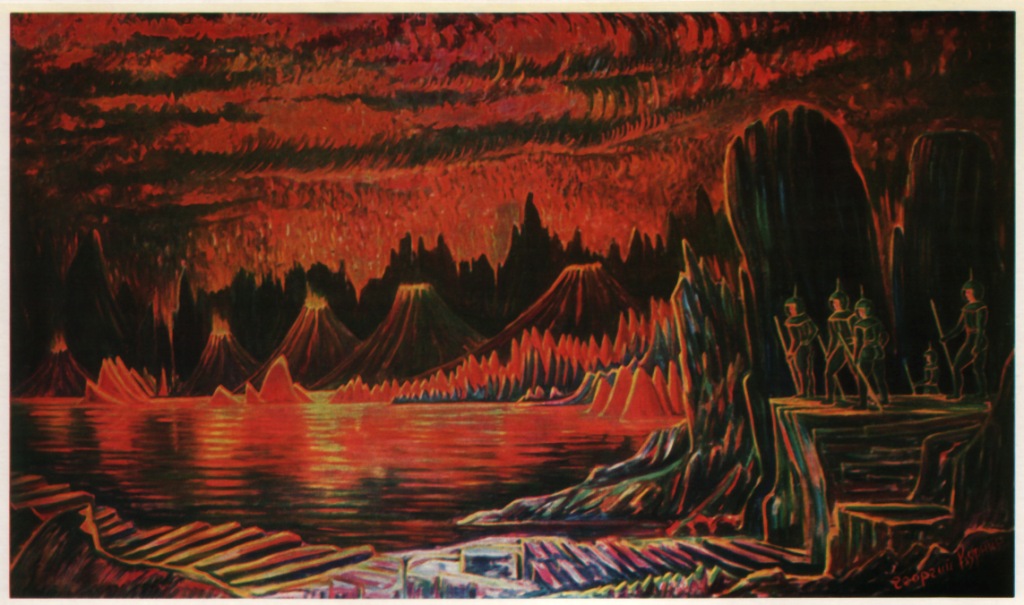
The birth of a planet in a system of two suns
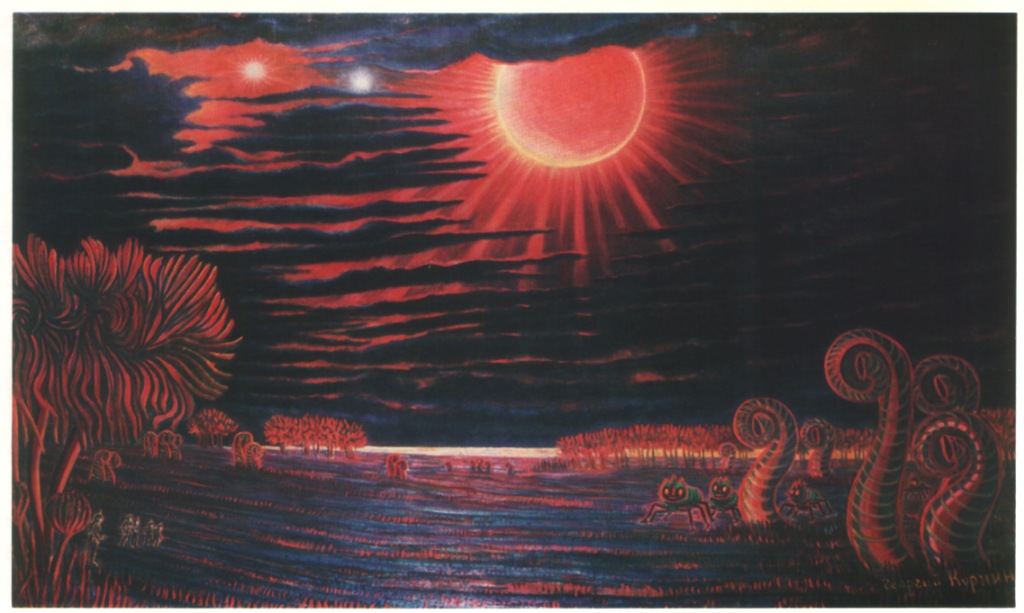
Planet of the Three Suns (First Contact)
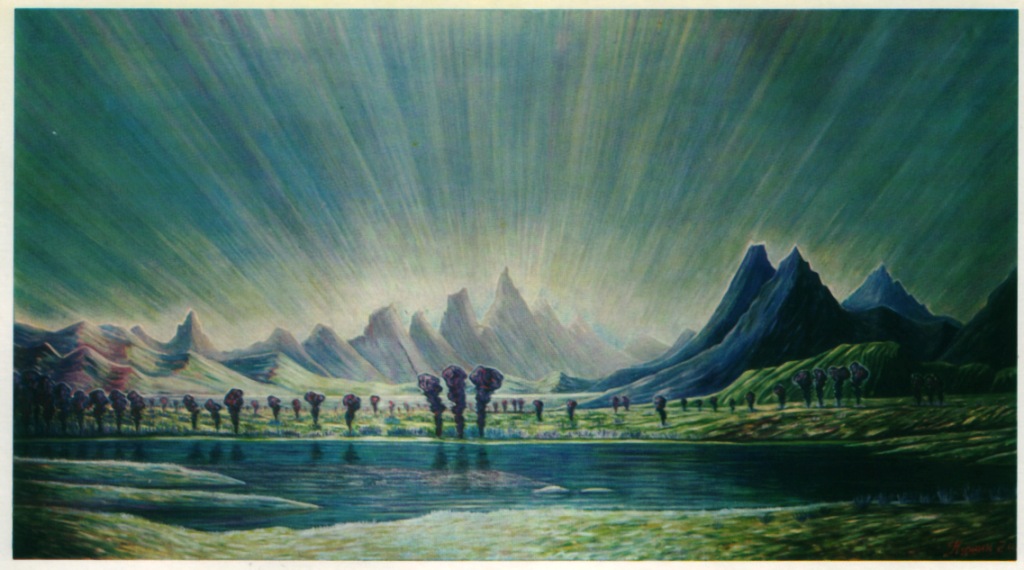
Planet of the Emerald Green Sun
He was born in 1915 in Tashkent. He graduated from the Tashkent Art College, the Faculty of Art Studies of the Central Asian State University. Author of a number of landscapes dedicated to Central Asia. He had a unique visual memory, and therefore never wrote from nature. In 1949 he moved to Sochi, where he lived until the end of his days. I lectured on art history topics for Sochi artists. In the 70's with the creativity of Kurnina met cosmonaut Vitaly Ivanovich Sevastyanov, who later exerted a lot of effort to popularize the creative work of an extraordinary artist.
Reproductions of Kurnin's paintings were published in magazines and almanacs: "Technique - Youth", "Smena", "Ogonek", "The Soviet Union", "Ural Pathfinder", "Fantastic" - 1973-1976.
Kurnin's paintings were exhibited: at the International Congress of Astronauts in Baku, at the Moscow House of Scientists, at VDNKh. In Hungary, Czechoslovakia, Poland. (1973-1974)
He died on April 14, 1988 in Sochi. He was buried in the Old part of the Central Uspensky cemetery in Sochi.
About Kurnin three days before his death was filmed a television film, shown posthumously on Moscow television.

Planet of the Great Red Sun

Supernova explosion

Landscape of Mars in the polar cap region

Landscape of the Moon, illuminated by the Earth

The birth of a planet in a system of two suns

Planet of the Three Suns (First Contact)

Planet of the Emerald Green Sun
Georgy Iosifovich Pokrovsky
Georgy Iosifovich Pokrovsky (1901-1979) - scientist-physicist, major general of engineering and technical service, Honored Scientist of the RSFSR (1967). Doctor of Technical Sciences. Known also as a science fiction artist.
The first in the USSR proposed the creation of a long-distance expeditionary cross-country vehicle in 1936. It shows the main areas of application of large all-terrain vehicles: cargo transportation, research and rescue operations - regardless of weather, ice and soil conditions. Among the design features predicted by Pokrovsky: movement in the water by rewinding caterpillars with developed grooves, a large width of the tracks, which provides low ground pressure, diesel as the main engine.
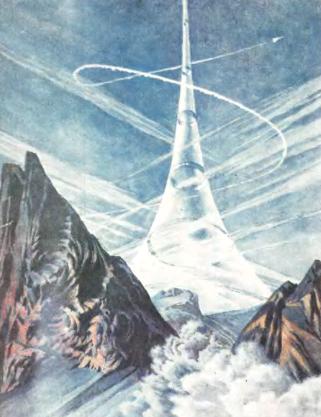
Thin-film tower - weightless elevator into space

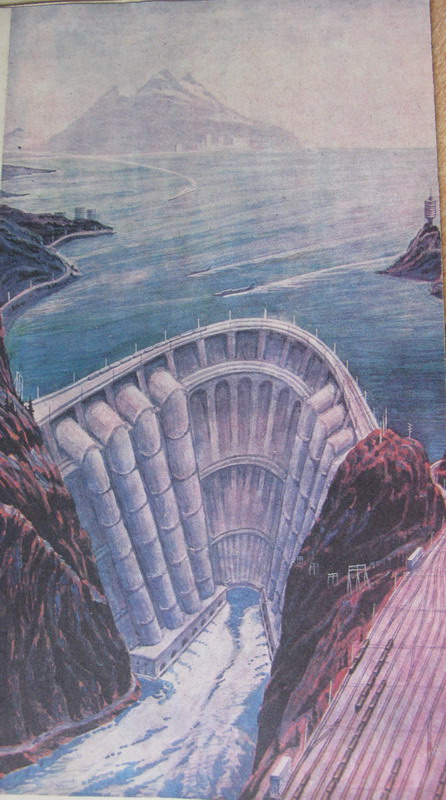
The dam in the mountains - the second nature created by man
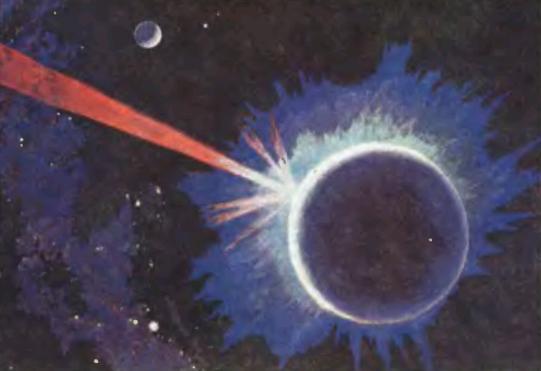
Space disaster
The first in the USSR proposed the creation of a long-distance expeditionary cross-country vehicle in 1936. It shows the main areas of application of large all-terrain vehicles: cargo transportation, research and rescue operations - regardless of weather, ice and soil conditions. Among the design features predicted by Pokrovsky: movement in the water by rewinding caterpillars with developed grooves, a large width of the tracks, which provides low ground pressure, diesel as the main engine.
Thin-film tower - weightless elevator into space


The dam in the mountains - the second nature created by man
Space disaster
Nikolai Mikhailovich Nedbailo
Nedbailo Nikolai Mikhailovich (1940) is a Soviet and Russian artist. Originally from Moscow region, from the family of artists in several chambers. He studied at the Moscow Art College name of 1905. Illustrated popular magazines. Laureate of the contest of science fiction artists. Representative of the "naive" direction in painting.

Lighthouse Planet

Gardens of Solaris

Galactic Maneuver
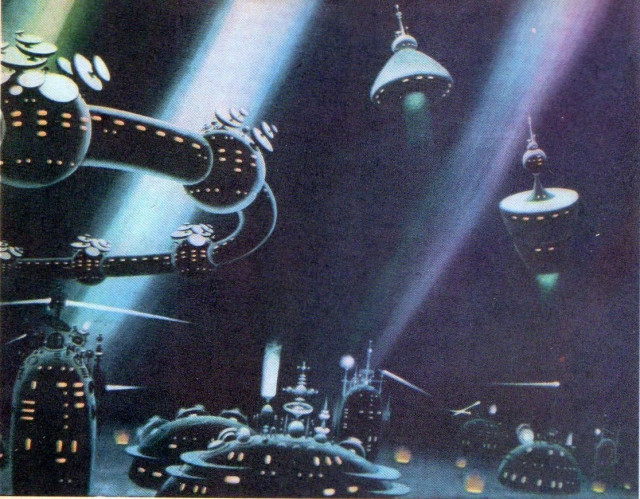
Moscow
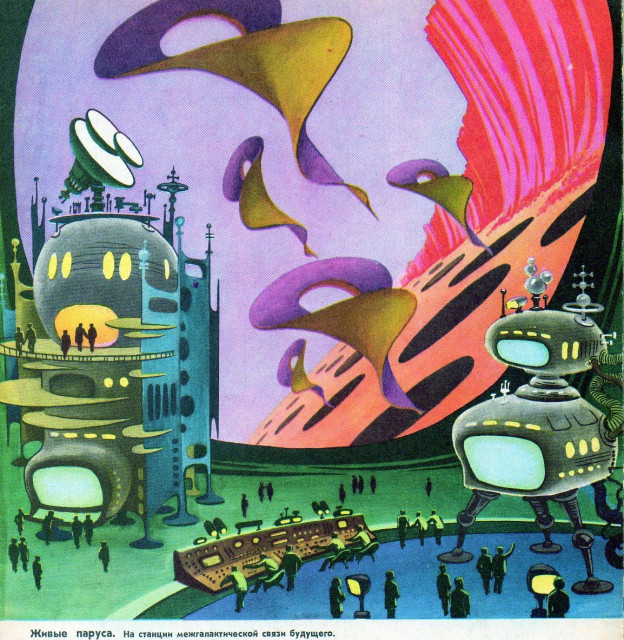
Moscow Cosmodrome
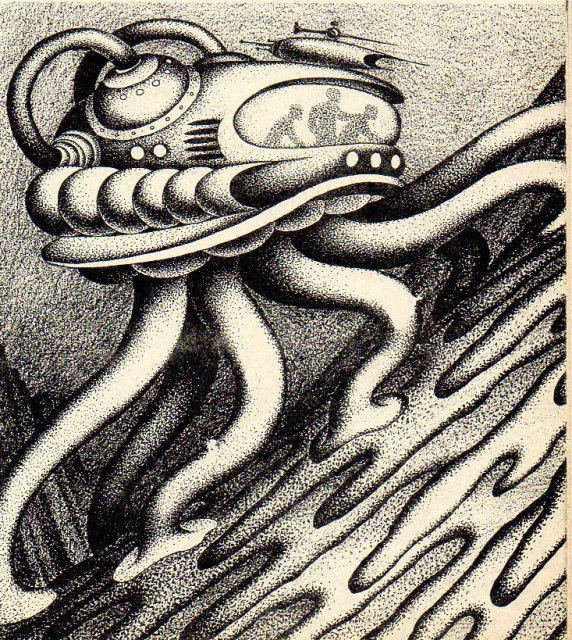
Journey

Lighthouse Planet

Gardens of Solaris

Galactic Maneuver
Moscow
Moscow Cosmodrome
Journey
YeahOkayCool
Banned
Interesting. Did the USSR ever have a genre analogous to the pulp sci-fi of mid-century America? I can't help but think that some of these wouldn't look out of place on the cover of an issue of Super Science Stories or something similar.
Share: